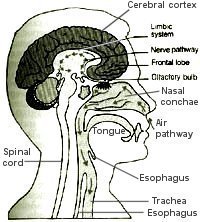| |
alternatives treatment of autoimmune disease read our e-book
Special Google
Health Search
Contents
Neurons and Nerves
Neurotransmitter
The Brain
Spinal Cord
Peripheral
Nervous System
Autonomic
Nervous System
Senses:
Sight,
Senses,
Smell,
Taste,
Sences,
Senses
Memory
Higher Functions
Altered States
-
 |
- Olfactory area - Nerve signals representing smells
are routed to two regions of the brain: the medial
(inner) olfactory area and the lateral (side) olfactory
area in the amygdala. Figure 18 shows the pathway of the
odorants in the air, which initiates impulses moving
along the nerve pathway to the brain. Since the nerve
pathway is in part of the brain's limbic system, which
also deals with memories and emotions, smell can evoke
strong emotion from past experience about a certain
odor. Smell is the sense in which habituation occurs
most quickly. Habituation is the process in which a
sense becomes accustomed to what it detects so that it
is no longer perceived. Most odors can hardly be
perceived just 30 seconds after they are first detected.
|
|
The sense of taste
and the sense of smell supplement each other, creating a
combined effect when interpreted by the cerebral cortex.
For example, some of the molecules may move from the
nose down into the mouth region and stimulate the taste
buds there. Therefore, part of what we refer to as smell
actually may be taste. |
Taste (see location of the various
components in Figure 09):
Go to
tounge and papillae
|
|
|
|
|
|
|